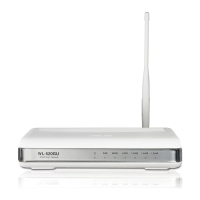How to restore Asus WL-520gU to default settings?
- JJoshua JimenezJul 30, 2025
To restore your Asus Wireless Router to its default settings, press the Restore button on the rear panel of the router for more than five seconds.

How to restore Asus WL-520gU to default settings?
To restore your Asus Wireless Router to its default settings, press the Restore button on the rear panel of the router for more than five seconds.
What to do if my Asus WL-520gU Wireless Router ADSL “LINK” light is blinking?
Ensure all cables are properly connected. If the ADSL light continues to blink or remains off, disconnect the power cord from the ADSL or cable modem, wait a few minutes, and then reconnect it. If the issue persists, you should contact your ADSL service provider.
What to do if client cannot establish wireless connection with Asus WL-520gU Wireless Router?
If a client device can't connect wirelessly to the Asus Wireless Router, it could be due to several reasons. If the client is out of range, move the router closer. You might also try changing the channel settings. For authentication issues, use a wired connection to connect to the router and check the wireless security settings. If you can't find the router, press the Restore button on the rear panel for more than five seconds, and check the SSID and encryption settings in the wireless adapter.
What to do if I cannot access the internet via wireless LAN adapter on Asus WL-520gU Wireless Router?
If you cannot access the Internet via a wireless LAN adapter, move the router closer to the wireless client. Check that the wireless adapter is connected to the correct wireless router and that the wireless channel conforms to the channels available in your country/area. Also, verify the encryption settings and ensure the ADSL or Cable connection is correct. You can also try using another Ethernet cable.
What to do if I forgot my Asus Wireless Router network name or encryption keys?
If you've forgotten your Asus Wireless Router's network name or encryption keys, try setting up a wired connection and configuring the wireless encryption again. Alternatively, press the Restore button on the rear panel of the wireless router for more than five seconds.
| Bandwidth | 2.4 GHz |
|---|---|
| xDSL connection | No |
| Dimensions (WxDxH) | 164 x 116.5 x 31 mm |
| Power requirements | +5V; 2A |
| USB ports quantity | 1 |
| Filtering description | URL |
| Maximum data transfer rate | 0.125 Gbit/s |
| Compatible operating systems | Windows 2000/XP/Vista |
| Full duplex | Yes |
| VPN support | IPSec, PPTP, L2TP |
| Networking standards | IEEE 802.11b, IEEE 802.11g, IEEE 802.11i, IEEE 802.1x, IEEE 802.3, IEEE 802.3u |
| Channels quantity | 13 channels |
| Ethernet LAN (RJ-45) ports | 4 |
| Security algorithms | WPA, WPA-PSK, WPA2 |
| Authentication method | 802.1x RADIUS, MAC |
| Storage temperature (T-T) | -30 - 50 °C |
| Operating temperature (T-T) | 0 - 40 °C |
| Storage relative humidity (H-H) | 20 - 90 % |
| Operating relative humidity (H-H) | 50 - 90 % |
| LED indicators | LAN, WAN |
| Weight | 262 g |
|---|
Lists items included in the wireless router package.
Specifies the necessary hardware and software for setup.
Outlines essential guidelines before starting the installation.
Describes the indicators and ports on the front of the router.
Details the ports and buttons on the rear of the router.
Describes the vents and mounting hooks on the bottom.
Explains how to mount the router on a surface.
Guides on initial router setup and EZSetup utility.
Instructions for connecting the router via an Ethernet cable.
Steps to connect the router wirelessly.
Overview of accessing and using the web GUI for configuration.
How to access and navigate the router's web interface.
Requirements for accessing the router.
Explains DHCP and manual IP configuration for clients.
Steps to configure IP settings in Windows 9x/ME.
Steps to configure IP settings in Windows NT 4.0.
Steps to configure IP settings in Windows 2000.
Steps to configure IP settings in Windows XP.
General guide to using the router's web interface.
How to view network status and configure connections.
Guide to automatically detect and set up WAN connection.
How to prioritize network traffic for better performance.
Steps to update the router's firmware.
Procedures for managing router configuration settings.
Instructions for installing utilities from the support CD.
Utility to detect and configure ASUS Wireless Router devices.
Utility to restore router firmware after a failed upgrade.
Utility for easy setup of secure wireless networks.
How to add devices to the network using EZSetup and a USB drive.
Utility to set up a USB printer on the router.
Troubleshooting steps for web browser, wireless, and internet access problems.
Recovering forgotten network keys and resetting router to defaults.
Contains FCC statements, co-location prohibition, and related notices.
RF exposure guidelines and general safety precautions.
Product compliance with R&TTE directive.
Information regarding CE mark compliance and potential interference.
Licensing terms for included software.
Contact details for ASUS technical support and offices.
Formal declaration of product conformity with standards.